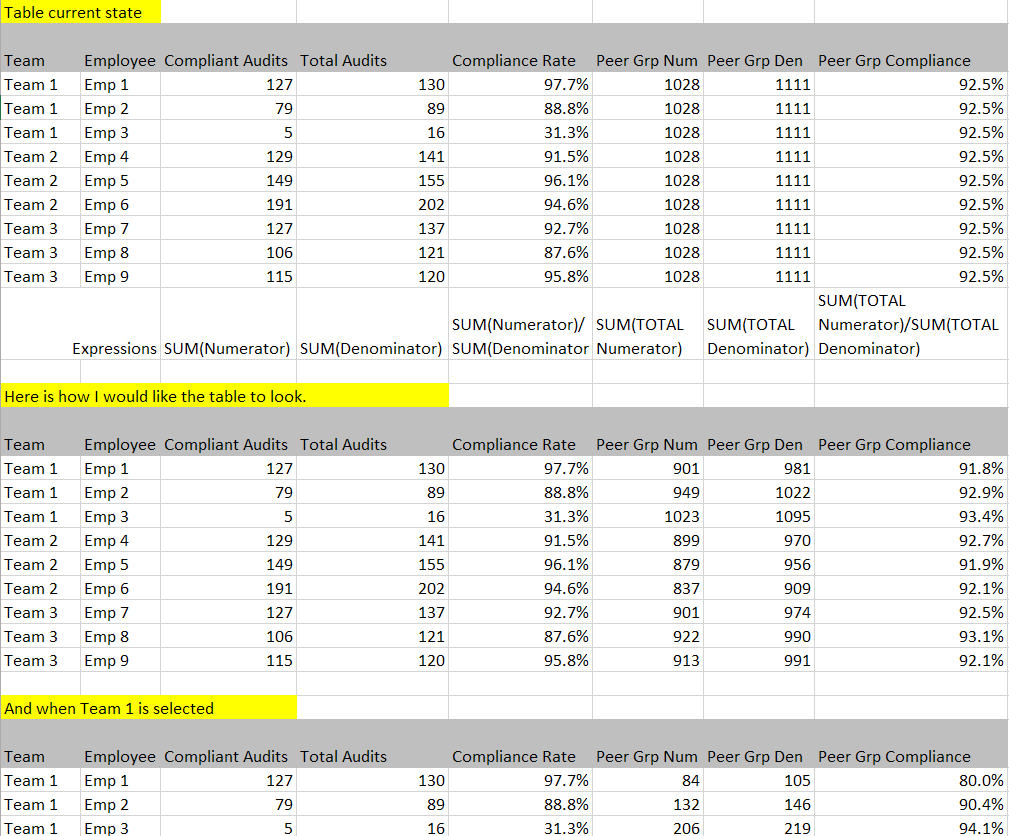Unlock a world of possibilities! Login now and discover the exclusive benefits awaiting you.
- Qlik Community
- :
- Forums
- :
- Analytics
- :
- App Development
- :
- Re: Exclude current row dimension from TOTAL expre...
- Subscribe to RSS Feed
- Mark Topic as New
- Mark Topic as Read
- Float this Topic for Current User
- Bookmark
- Subscribe
- Mute
- Printer Friendly Page
- Mark as New
- Bookmark
- Subscribe
- Mute
- Subscribe to RSS Feed
- Permalink
- Report Inappropriate Content
Exclude current row dimension from TOTAL expression in a table
I am working on an application comparing performance of employees to a group of peers in a table. Each row is dimensioned by the employee and contains a compliance rate SUM(numerator)/SUM(denominator) and is being compared to SUM(TOTAL numerator)/SUM(TOTAL denominator). However, this compares the employee compliance rate to the group's compliance rate including the employee in the current row. I would like to compare the employee to the group excluding the employee in the current row.
Accepted Solutions
- Mark as New
- Bookmark
- Subscribe
- Mute
- Subscribe to RSS Feed
- Permalink
- Report Inappropriate Content
I have found a solution. Much simpler than I expected. I was overthinking it as usual.
To calculate the sum of all rows other than the current row, subtract the current row sum from the TOTAL sum.
So for my question as example:
(SUM(TOTAL Numerator) - SUM(Numerator)) / (SUM(TOTAL Denominator) - SUM() Denominator)
This will give the aggregated compliance rate of all employees other than the current row employee.
- Mark as New
- Bookmark
- Subscribe
- Mute
- Subscribe to RSS Feed
- Permalink
- Report Inappropriate Content
Hi,
can you add more details about the expected output ? like a screen shot of your table ? of your data structure ?
- Mark as New
- Bookmark
- Subscribe
- Mute
- Subscribe to RSS Feed
- Permalink
- Report Inappropriate Content

- Mark as New
- Bookmark
- Subscribe
- Mute
- Subscribe to RSS Feed
- Permalink
- Report Inappropriate Content
Can you share the source file ? or at least some rows ?
- Mark as New
- Bookmark
- Subscribe
- Mute
- Subscribe to RSS Feed
- Permalink
- Report Inappropriate Content
The employee data is confidential and cannot be shared. I have attached a blinded basic application.
- Mark as New
- Bookmark
- Subscribe
- Mute
- Subscribe to RSS Feed
- Permalink
- Report Inappropriate Content
I have found a solution. Much simpler than I expected. I was overthinking it as usual.
To calculate the sum of all rows other than the current row, subtract the current row sum from the TOTAL sum.
So for my question as example:
(SUM(TOTAL Numerator) - SUM(Numerator)) / (SUM(TOTAL Denominator) - SUM() Denominator)
This will give the aggregated compliance rate of all employees other than the current row employee.